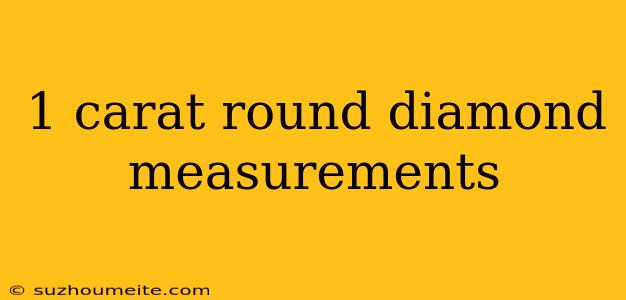1 Carat Round Diamond Measurements: A Comprehensive Guide
When it comes to diamonds, carat weight is a crucial factor in determining their size and value. A 1 carat round diamond is a popular choice for engagement rings and other fine jewelry, but what exactly are the measurements of a 1 carat round diamond?
What is a 1 Carat Diamond?
A carat is a unit of weight, with 1 carat equivalent to 0.2 grams or 200 milligrams. In the context of diamonds, carat weight is used to describe the weight of a stone, with larger diamonds being more rare and valuable. A 1 carat diamond is a significant size, often considered the threshold between smaller and larger diamonds.
Measurements of a 1 Carat Round Diamond
A round diamond, also known as a brilliant cut, is the most popular diamond shape. The measurements of a 1 carat round diamond can vary slightly depending on the specific cut and proportions, but here are the typical measurements:
- Diameter: 6.4 - 6.5 millimeters (mm)
- Circumference: 20.1 - 20.3 mm
- Depth: 3.9 - 4.1 mm
- Table size: 55 - 58% of the diameter
- Crown angle: 34.5 - 35.5 degrees
- Pavilion angle: 40.5 - 41.5 degrees
How Do These Measurements Affect the Diamond's Appearance?
The measurements of a 1 carat round diamond have a significant impact on its appearance. Here's how:
- Diameter: A larger diameter means a bigger diamond, which can make it appear more impressive and sparkly.
- Depth: A deeper diamond can appear smaller than a shallower one of the same carat weight, as more of the diamond is hidden beneath the surface.
- Table size: A larger table size can make the diamond appear more brilliant, as it allows more light to pass through the stone.
- Crown and pavilion angles: These angles affect the way light is refracted through the diamond, with ideal angles creating a more brilliant and fiery appearance.
In Conclusion
A 1 carat round diamond is a stunning choice for any jewelry piece, but understanding its measurements is crucial in determining its size, appearance, and value. By considering the diameter, depth, table size, and crown and pavilion angles, you can make an informed decision when selecting the perfect diamond for your needs.
